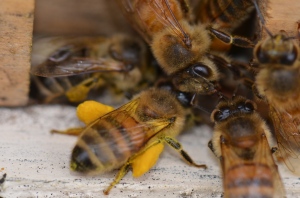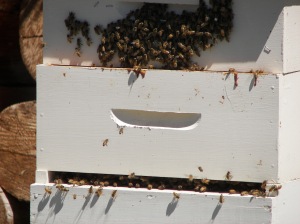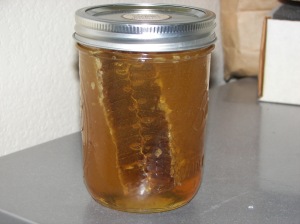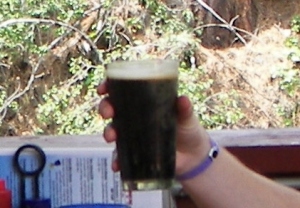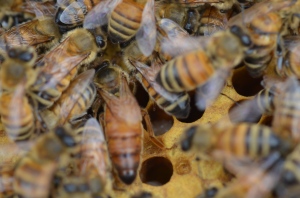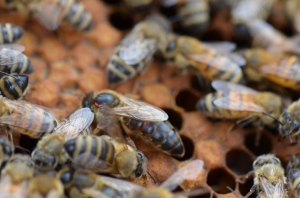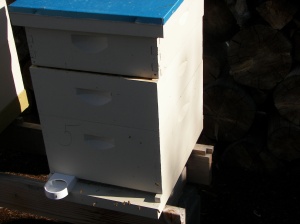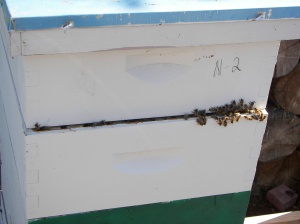Please go to PerfectBee – http://www.perfectbee.com/ to see my latest article entitled “Natural Beekeeping”. I hope you will continue to follow along at Perfect Bee.
Author Archives: Ron Lane
Quick Update
For those of you who have been checking in here for beekeeping advice and updates I must apologize. My schedule is just too full to be able to continue with this blog. I took on teaching beekeeping classes this year, am taking Master Beekeeping classes from O.S.U. and have recently reached an agreement to write for PerfectBee. (You should check them out.) All this in addition to maintaining hives in three different apiaries.
I would like to thank those who have followed along. If you would to continue to follow me then please check out PerfectBee where you will soon find my Bio and first articles.
Thank you!
First inspection of 2016
Greetings and my best to all of you and your bees in 2016.
I’ve been anxiously awaiting the first mild day of the new year that would allow me to make a quick inspection of some of my hives and yesterday (the 7th) was just the day. The temperature was only 43 to 44 degrees, but there was no wind and the sun had been shining on the hives for most of the day, allowing them to warm up inside.
We’ve had a long stretch of cold weather that forces the bees to remain in their cluster and not allow them to move about in the hive to reach new stores of food. I was concerned that the bees could become isolated to one side of the hive, use up the food stored there and potentially starve because it had not been warm enough for them to move to the other side of the hive where more food was stored. So that was the objective I was looking to accomplish with a quick hive inspection. Which, by the way, is how you should approach every hive inspection, no matter what time of year it is, know your reason for the visit ahead of time.
In all I viewed four hives and spent no more than five minutes inside any hive. Two hives were in great condition. Plenty of food stores accessible to the bees and lots of bees. I spent just a couple minutes in these hives. The third hive turned out to be exactly as I had feared. They were not out of food but very close to it and they were isolated on one side of the box, five frames away from the nearest frame with honey and pollen. I spent a full five minutes in this hive as I needed to move the food stores next to the bees.
You do not want to break up the area where the bees are clustered by placing a frame in of stores in the middle of it. Instead you should move the frames with food stores immediately next to the cluster. I even pulled my hive tool across the capped honey to scratch it open just a bit, allowing them to access it more easily. Now that food is nearby I can rest assured this hive will not starve because they became isolated away from their stores.
The fourth hive I checked was dead. This was not a surprise. The hive had a mite count of 12 percent in September. Anything over five percent is supposed to be treated. For the most part I don’t use chemicals in my hives and so this hive was on its own.
For those of you who do use chemicals in your hives, here is a thought to consider. New on the market this year is oxalic acid. (Its been used in Europe with great success for many years) This is a naturally occurring chemical you find in Rhubarb and other common garden plants. Brushy Mountain bee supply has some good information on it if you want to visit their web site. If you choose to treat with chemicals, this “soft” treatment (called that because its organic) is something you may want to consider. AND, this is the time of year to apply it because there is no capped brood in the hive yet and therefore no place for the mites to hide. (the oxalic acid gas will not kill mites sealed in capped brood) Be sure to read up on the safety precautions if you choose to go this route.
That’s it for now. When the weather allows, be sure to check on your hives to see if there is enough food to see your girls through to spring and if you need to move some of the food they have stored next to where they are clustered so they can access it.
Winter Prep/Classes
Are your bees snuggled into their hives with plenty of stores to see them through the winter? Do you have a healthy queen with a small, but solid brood pattern? Do you have some weak hives that might not make it through the winter?
These are things you need to be looking for as the winter storms begin to roll in. Weak hives can be combined to make one strong hive. You might even add some honey frames that you have saved back, or take them from strong hives that can spare them so other strong hives that need a boost in stores have what they need to get through the winter.
A good wind break is always helpful and some people wrap their hives with tar paper, but if you do, be careful not to close them up so tight they don’t breath and don’t make the mistake of closing up your hives so the bees cant get out for cleansing flights. As your bees burn through their honey they will produce moisture that condenses on the inside of the hive. You do not want this dripping down on the bees as it will kill them. A simple solution is to slide a small piece of wood 3/4 of an inch thick or so (but no larger than an inch think) under the back of the hive so the moisture that collects inside will run to the front and down the front wall of the hive. Also make sure you have your mouse guards in place. Mice can quickly make a mess of any hive.
Here are some interesting temperature guidelines for different bee activities.
- 93-94 brood nest temp for eggs and young bees
- 68 queen does not fly
- 61 drones cannot fly
- 57 the winter cluster forms
- 50 workers cannot fly
- 40 bees die if alone
I’ve been busy preparing for the classes I will teach beginning this January. They will encompass a full season of beekeeping. For the local folk out there who have been following along, if you are interested in taking these classes please contact me at – whalersman@gmail.com
We will begin with the basics and later move into the more complex. Classes will be held near one of my bee yards so you can get hands on experience and learn how to do a hive inspection and gain an understand what you are looking at.
Mite Season
Its that time of year when mite counts skyrocket. If you haven’t been doing mite counts over the course of the summer you may be a bit behind the curve, but there’s still time if you act now.
To win your battle against mites you must know how many mites are in your colonies. An easy way to do this is with a powdered sugar roll. Take a pint jar and replace the lid with hardware cloth. (Keep the ring to hold the mesh in place) The openings in the metal screen need to be small enough to keep the bees in the jar but large enough that you can drop in the powdered sugar.
Now, off to the beeyard. You will need to take with you a small shallow tub (white color works best), powdered sugar, some water and a tablespoon. Open the first hive and look for a frame of larva/brood. You are looking to sample the nurse bees that are caring for the larva and brood. Making sure the queen is not on the side of the frame you are sampling, then slide the jar (with the lid off) down the board, causing the bees to fall backward into the jar. You want half a cup of bees (approximately 300 bees) so mark your jar with a line measuring half a cup prior to going to the beeyard. (You can also shake bees from the frame into the plastic tub you brought with you and then pour them into the jar.)
Once you have half a cup of bees quickly put the mesh screen lid back on the jar. Then add two tablespoons of powdered sugar through the mesh. Roll and gently shake the bees for a few minutes until they are coated in powdered sugar and set the jar aside for one minute or so. While they sit, ready your tub. Pour in enough water to just cover the bottom of the tub – just enough to melt the powdered sugar when you pour it in.
When a minute is up, vigorously (but not hard) shake the jar over the water in the tub. The powdered sugar will melt and the dark colored mites will be easy to spot against the white background of the tub. Count the mites and return the bees to the colony unharmed.
Divide the number of mites by 300 (the number of bees in the jar) and you will have a percentage of adult bees that have mites. Anything under 5 percent is considered safe. If there are more than that you may want to consider treating your hive as the skyrocketing mite population needs to be knocked down fast. (Remember also that this only represents about 20 percent of the total mites. Approximately 80 percent of the mites are inside cells and not on the bees.)
If you have reached the conclusion that you must treat, probably the best option for this time of year is a product called Mite Away Quick Strips. This product contains formic acid. Its quick, effective and is said to leave no residue though it can harm queens and brood if applied when temperatures exceed 85 degrees. This product REQUIRES the use of gloves and a mask! So be careful to follow directions. But it is by far the most quick and effective product.
There are always trade offs when using chemicals in your hives and only you can decide if it is to be part of your hive management regimen. Proper management can reduce hive loses without using chemicals but part of managing your colonies is learning how to take mite counts and then doing the counts often enough to know what is taking place in your hives.
Winter Hive Prep.
Winter’s not here yet, but it is time to think about preparing your hives for winter here in the high desert of Central Oregon. If you have staggered the hive boxes to help with summer ventilation, such as in the picture above, its time to close them up if you have not already done so.
Most importantly its time for a hive check to see if your bees have enough stores for winter. Big strong hives will have put away plenty of extra honey making it possible for you to share in the bounty. BUT WAIT! Check your other hives first. If you have made some late season splits or simply have a hive that has not done as well as you would hope, pull some frames of honey from the strong hives and share it with the weaker hives. That way everyone is set for winter.
If your hives are low on stores and you need to feed, you want to feed a 2 to 1 mixture of sugar and water. Two parts sugar to one part water. Takes lots of stirring and hot water!
This is also the time of year the mite populations peak. Do a mite count and see how your hives are doing. One way to do a mite count is with a powdered sugar roll. Collect one cup of bees and add them to a pint jar that is then capped with a screened lid. Through the screen add a heaping tablespoon of powdered sugar. Roll the jar to coat the bees and then let the jar sit for one minute. After a minute, take the jar and shake out the powdered sugar (and mites) into a pan with a very shallow layer of water. The water will melt the powdered sugar and reveal the mites. Count your mites.
There is about 300 bees in a cup and you divide your mite count by 3 to get mites per 100 bees – or a percentage. Anything over 5 percent and you may want to treat. If you have been following along with my blog you know we don’t use chemical miticides in our hives. Instead we create brood breaks to control mites and use essential oils. If you must use a miticide, I suppose the Mite Away Quick Strips (MAQS) would be a choice to make as they are an organic acid that is corrosive, not toxic, thereby killing the mites physically and giving them little chance to build resistance. Beware though! A respirator is suggested use when applying this treatment and you would not want to apply the MAQS when temps are expected above 85 or you may harm the queen. MAQS are effective but they are expensive and somewhat hazardous to apply.
If you prefer a softer, natural approach, use food grade organic essential oils. Its not a silver bullet and not an immediate kill like the MAQS, but it is organic and will help to control your mites. To make a concentrate, add 1 teaspoon of Wintergreen oil, 3/4 teaspoon Tea tree oil, a few drops of spearmint and a few drops of lemongrass oil to one cup of water in a blender and run on low for five minutes. When done add this to a half gallon jar of water. This is your concentrate. When you feed this to the bees you add one cup of the concentrate to one gallon of 2 to 1 feed.
If your creating brood breaks during the season and following up with essential oils, you will lose very few hives to mites without using chemicals.
Dog Days of Summer – And Honey Too!
That’s the Burls! And Burly Dog thinks its just too stinking hot to be doing much outside. (over 100 the last couple days) So I’m writing this little piece instead.
That there is a beautiful jar of comb honey! I’m about half way through my honey harvest this year and this comb is cut from a foundationless frame of honey comb. Using a foundationless frame gives you a deeper comb.
It’s also time for some mite control. If you’ve been reading this blog for very long you already know that Worker Bee Honey is entirely free of miticides. (Insecticides used in the bee hive to kill mites – I mean really, who wants an insecticide in their honey? Those who purchase store bought honey???) Anyway, the best and most natural way to control mites is to split your hives, thereby eliminating the mites food supply for approximately 30 days and achieving nearly a 100 percent mite kill. I’ve already done that with most of my hives this year but for those I did not split I am going to feed some essential oils.
I do this twice a year, spring and late summer/fall, but this time of year the yellow jackets are on the prowl and feeding a syrup can encourage robbing. So I’m going to share with you an essential oil recipe for making patties. You may wonder about feeding right now. Well most people do wait until a little later, but think about it. If you did a mite count right now you are likely going to find a high count in the hives you did not split. Mites bring disease and sometimes the hive is succumbing to the diseases the mites bring long before the mites bring down the hive. No reason to let those little buggers run around in your hive any longer than necessary. Even though everything used in the essential oil mixture is organic, food grade, I do this after I have harvested the honey I’m going to take from the hive.
After much digging and research on the web I have found patty recipe that delivers approximately the same level of essential oils as the syrup recipe I have been using, with some minor differences. This recipe makes 20 to 25 patties depending on how large you make each of them.
- 3 Pounds of cane sugar (Use cane sugar because beet sugar is from GMO beets in the US)
- 1 Pound of Shortening (Organic Palm oil works well, but if you don’t have it available use an organic vegetable shortening)
- Spearmint 5 3/4 teaspoon
- Thyme 5 3/4 teaspoon
- Tea Tree 3 3/4 teaspoon
- Lemon Grass 7.5 teaspoon (All of these are food grade of course)
- 3 Tablespoons Honey (from your own hives)
- 1 Tablespoon of Vinegar
- 4 Tablespoons of Nozevit (Produced from certified organic plant material) It restores the natural PH and elasticity in the bees mid gut and contains probiotics that help bees digestion.) Helps prevent and control nosema.
Mix the essential oils into the sugar, either by hand or with a hand mixer. Then add the honey and vinegar. (white vinegar or organic apple cider) Vinegar brings the PH of the mixture closer to the ph of honey which makes it easier for the bees to digest. Then add the Nozevit. Finally, add the shortening. Mix until the mixture is smooth and there are no lumps. There should be just enough shortening to hold the mixture together.
I like to make the patties in the kitchen and lay them out between layers of wax paper, then take however many I need depending on the bee yard I’m going to visit. Makes 20 to 25 patties depending on how large you make them. If you don’t want to use syrup this fall, then give this recipe a try.
That’s a frosty adult beverage. It probably looks pretty good right now if your hiding out inside the house with the a/c on waiting for cooler temps before you mix up your patties and go to the bee yard.
Cheers!
The Longest Day
Did you know that big beautiful queen you have working away in your hive has already begun to taper off her laying? That’s right. After the summer solstice, June 21st, the days begin to shorten, and though its gradual at first, your queen is beginning to reduce the rate at which she lays. The length of the day governs her rate of laying. It wont be noticeable for some time to come as the eggs she has been laying at a peak rate will not produce their young for weeks to come.
It wont be noticeable right away, because in August your hive will brim to overflowing with bees and on those hot days you will see a lot of them hanging out on the front porch of the hive. (Or as a crusty old timer friend of mine says, “they just like a bunch of teenagers sitting around on the front porch smoking dope”.) I love the humor but normally what they are doing is fanning the hive to help keep it cool.
Queens born AFTER the summer solstice will lay eggs at a high rate, just like a spring queen gearing up for summer, because they have not experienced the summer solstice. Their egg laying rate will exceed that of a queen who lives through the summer solstice for about five to six weeks before it begins to taper off in preparation for winter.
This is a great time to split hives if you want replacement nucs or nucs to sell next spring. Do a split today, June 28, and you will have a laying queen in the hive approximately 30 days from now, or about the 28 of July. Just enough time for her to produce enough young to lay in the stores they need (you made need to feed just a little) and produce a large enough population to see the hive through the winter. I did it last year on July 1 and every nuc (five of them) not only wintered, but exploded in growth this last spring when that young queen began laying at her full potential.
The longest day has already come and gone and believe it or not, just about the time you are kicking back in the shade with a cold lemonade or adult beverage on that hot summer day, your queen is thinking along the same lines and reducing her egg laying. But don’t let that deter you from making some splits right now, splits that will serve you exceedingly well come this next spring.
May the honey soon flow and may it bee ever so sweet!
Cheers!
Help Your Bees Beat the Summer Heat
Today’s temp. will near 100 degrees. Now I know for a lot of you that may not be a big deal as you’ve probably already seen temps like that this year, but in Central Oregon this is our first real wave of hot weather this year. So here’s a little trick to help your bees deal with the heat.
Naturally you always want to have a good source of water nearby. The next thing you can do is to push back the top box on your hives to create a top entrance for the bees. This helps air flow through the hives and improves ventilation. That means more bees working to store honey and fewer bees working to cool the hive.
Secondly, a top entrance makes it easier for the bees to access the upper boxes. By this time of year the lower boxes are filling with brood and when the field bees come into the bottom of the hive they must struggle against a hive full of bees to get to the top boxes. Often times they will store the pollen and nectar they carry in the brood nest at the bottom of the hive and force the queen to move further up into the hive as she runs out of room to lay her eggs in the brood nest.
Consequently a lot of people put on queen excluders to keep the brood our of their honey boxes. I’ve never used queen excluders and have found no need to do so as long as I open up the top of the hive like you see in the pictures.
So do your bees a favor and give them a little air conditioning. It’s easier on the bees and they will reward you with beautiful clear honey.
First 21 days of a Bees Life
You will enjoy watching a bee develop from an egg to a larva to a bee, right before your eyes in only a minute or so time.
http://www.boredpanda.com/bee-life-timelapse-video-anand-varma/


